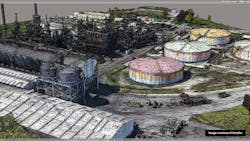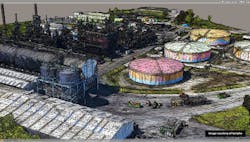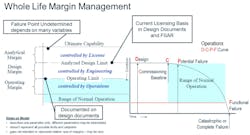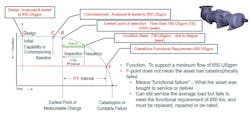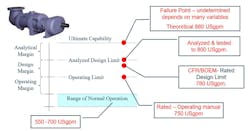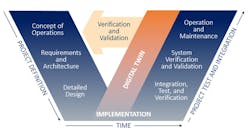Designing Process and Refinery Infrastructure for Reliability and Resilience
For decades, megaprojects in every industry have been designed to provide specific functionality or value with delivery and commissioning as the end goal. Large process and refinery projects, such as the construction of new oil rigs, processing plants or mining operations, usually qualify as megaprojects and share the same end goals.
Project management focuses on controlling schedule, scope and budget to meet the delivery goals. However, the success rate for the project management approach has been below expectations and shows no sign of improving.
Megaprojects have changed over the years due to currently available technology, financial landscapes and environmental issues. One example that affected the oil and gas industry was when the price of oil cost hundreds of dollars per barrel. At that time, oil companies were confident in their investments in megaprojects. The 2014 market price implosion for a barrel of oil directed a change for the oil and gas industry. Parallel arguments for mining occurred just a few years earlier as ore values also plummeted in most areas of the world. As a result, many capital projects required a fresh look, when cost-cutting measures were introduced.
Compelling reasons for change affect all types of industries at some point within their lifecycle. For instance, it became clear that new and more mature operating models were required in the aviation, automotive and steel industries. One way to ensure the industries were profitable was to build in resilience at the start of the project and to eliminate many reliability and operation problems early on, and throughout, its operating lifecycle. With oil prices stabilizing after the crash, operators are now forced to think differently when it comes to investing in megaprojects.
Designing for reliability at the beginning of a project is key for a more dependable, resilient and successful operation. The inclusion of a digital asset is the key to sustained asset lifecycle performance, and the incorporation of operating margins can help prevent unexpected failures during operation.
Failure Within Oil and Gas
A large part of the refining and processing infrastructure around the globe, particularly in oil and gas, was built in the late 1960s and early 1970s. While there are exceptions, many of these assets are still being operated well past their design life (between 30 to 40 years) and operating level. Documentation, if it exists, is likely to be inaccessible and inaccurate.
Many parts of the world suffer from investment deficit where economic growth has outpaced infrastructure investment. The oil and gas industry is renowned for being technologically behind other industries, which exacerbates the lack of information—particularly the ability to access usable information—even more.
Whenever an asset produces a lower value stream than it was designed to provide, failure has occurred. If a drill or a pump leads to production or uptime issues, the asset is trending toward failure. If the manufacturing quality of a piece of equipment is substandard, leading to frequent repairs resulting in planned and unplanned shutdowns, it is considered a failure. Reactive corrective actions result in increased maintenance costs no matter what type of failure occurred.
Whether they be pipeline leakages causing safety and environmental problems or pump failures, the end result failures can cost companies millions of dollars. Failures due to aging can cause unplanned downtime that impact reputation, investors and customer service, resulting in dissatisfied customers and negative publicity. Inability to achieve expected value means the asset is unreliable and lacks resiliency; it is not performing as intended and the investment benefits are not being obtained.
The days when cost recovery regulations allowed over-engineering and where the standard of performance meant throwing more money at the problem are over. Upgrade and replacement projects must be designed with closer tolerances, while being reliable and resilient, to meet the higher expectations of today’s smarter customers. Incorporating the initial value statement of the asset and measuring against this baseline throughout its life has become an essential requirement of a mature organization. Failure is not an option.
Designing for Reliability and Resilience
Designing for reliability and resilience takes a total expenditure (TOTEX) perspective. A term originally coined by Ernst & Young, TOTEX is the sum of capital expense and operational expense (CAPEX and OPEX). Designing for reliability moves the focus from a myopic view of creating the refining and processing asset record at the point of construction, or even energization, to consideration of the entire lifecycle of the asset. It is the creation of a full view line-of-sight of the asset over its entire life. At any point, a digital record in a connected data environment is available to inform with integrity and precision about what the asset was intended to do, and what has been done with the asset (and to the asset) up to the present.
Designing for reliability is asset-centric rather than document-centric. While the focus is on thousands of assets that comprise a system, system failures—which are just as challenging to maintain and reassess as individual assets—need to be considered as well. The level of preparedness taken after Hurricane Katrina hit the Gulf of Mexico is a prime example of system failure.
Ten years later, an even more violent storm hit the region in the form of Hurricane Harvey. While the storms themselves did not cause much damage to the assets within the refineries, the flooding was a major problem because it prompted electrical outages. The loss of electricity, which is needed to run the refineries, affected the oil companies, resulting in 22% of oil production in the gulf being offline for two to three days.
One could argue that these events are random; data science would tell us that random events are just elements of the business that are unmeasured or not fully comprehended. However, considering that hurricane season is an annual event and taking into account the overall cost (human, environmental and financial), failure to prepare and incorporate these realities into the asset management model would be negligent.
Creating a digital asset, or a digital asset information model that enables digital workflows, is an integral first step in designing for reliability and resilience process. There are few things as enduring through the lifecycle of an asset or facility as its asset information model, including the physical asset itself. While designers, operating personnel, technologies and software applications come and go, the asset information model continues to provide accurate, timely and relevant information to the workers who operate the network and associated assets efficiently and safely.
The structure of the information does not change much, but information for the digital asset is the golden thread linking the inception of the asset to its ultimate decommissioning. In fact, for a lot of the information, even decommissioning does not mark the end of the information lifecycle. There are countless types of documents and engineering information that, depending on the nature of the asset, must be maintained for legal reasons for years after the asset lifecycle ends.
Defining the function of the asset upfront enables the definition of the applicable design bases, design and operational margin, as well as the associated failure modes. The effect and consequences of the inability to function as per design may warrant a redesign or, in the event of a safety or environmental consequence, a redesign might be mandated.
In the event of lifecycle impact or operational effectiveness, a cost-benefit analysis may be required. Failure mode information needs to be provided as a prebuilt reliability program. When we design the information model with the end in mind, we link design, construction and operational information so that assets can be confidently operated within their design, safety and operational margins. These margins are contained in the functional requirements of the component, which in turn is embodied by the engineering tag.
As a design progresses and construction commences, the digital asset can be enhanced with a 3D model of the context in which the assets will live. Using aerial and other types of photography, as well as LiDAR, a 3D model of the asset (for example, a processing plant) is created and used to understand and analyze the impact of the real-world situation in which the asset exists, creating an understanding of topography, structures, buildings, roadways and much more.
Traditional design considers the how, what, why, when and where of a piece of equipment. To answer these new questions, digital models and simulation are used to design the optimal asset from a TOTEX perspective and from within the context of the real world to optimize the value stream over the asset’s total life. The asset record is created at the design stage, and it is subject to configuration management for the rest of its lifecycle.
Equally important, the digital record follows the asset into its operational life, facilitating analysis and informed decisions as it ages. Capturing system knowledge (of how everything works together) in a connected data environment for access by end-users in operations and maintenance is crucial to retaining designed value.
The challenge is to think about the information model as a continuous, evolving collection of connected information elements, all structured to enable and support efficient operations and modification activities. Information richness, interoperability and collaboration make optioneering throughout the asset lifecycle possible.
Reliability Centered Design
At its beginning, the function of refining or processing equipment is determined and documented along with asset performance criteria. Designing for reliability and resilience relies on risk assessment early in the design process by asking a key question, “What are the consequences of equipment failure?” Consequences related to failure include safety, environmental, loss of goodwill and operational impacts such as downtime.
With a probability estimate, risk can be defined as the product of consequence and probability. Designing for reliability identifies maintenance action plans to reduce the consequences of failure, minimize outage impacts and more. Maintenance action plans are prescribed actions to identify asset variances (inspections) or corrective, refurbishment and replacement plans that allow the asset to continue to deliver value.
Knowing methods of risk analysis, failure identification strategies and integrity and degradation strategies for upstream and downstream assets allows simulations to be run to determine the optimal strategy for risk mitigation based on risk tolerance against cost. Plotting risk against cost at the design stage is the most proactive process for optimizing TOTEX asset value.
Setting the Margin
Designing for reliability and resilience establishes a performance baseline for assets and serves as a record of the design performance expected from the asset. Having this baseline available at the beginning of the asset’s operational phase enables communication of operational variances from the asset’s intended functional values to be documented and communicated to stakeholders.
Margin management is the process of being aware of variances from each of the independent departure points (baselines) at each of the design, build, commission and operational phases. The process of measuring margin change (degradation) allows for proactive and appropriate maintenance actions to restore output to a value within an acceptable range.
The performance baseline defines a set of operating ranges from maximum capability (possibly set by an operating criterion or through testing) to design limit to operating limit and, finally, to functional failure. The set constitutes the performance envelope of the asset and enables one to answer the question, “Am I getting the value I expected from my investment?”
Consider a screw pump example: The design process establishes a screw pump operating limit of 880 United States gallon per minute (USgpm); however, the normal operating range of the transformer is 550 to 700 USgpm. The functional design limit constitutes a marginal allowance for over-operation without failure. The transformer may be capable of actual operation above the design limit, say 900 USgpm or more, although the failure point from maximum load may not be predetermined and operation beyond the design limit would entail risk.
In the figure below, the design limit is the commissioning baseline, 880 USgpm. As commissioned, the analyzed and tested capacity may hypothetically be 800 USgpm, but still above the functional operating limit of 550 to 700 USgpm. Inspection may detect a failure that lowers the upper limit to 780 USgpm, yet is still above the functional requirement for operations.
This deviance is still documented in the pump record as part of the lifecycle change management process, as well as any testing procedures or maintenance undertaken. At some point, the operating capacity may fall to 550 USgpm or less, below the functional requirement, at which point the transformer needs to be repaired, replaced or derated.
The inspection process that detects operating variances and the maintenance action plans triggered by the inspection is considered margin management with the goal of avoiding unexpected functional failures.
Practiced over the whole lifecycle of the asset, or in this case the pump, margin management allows for a progressive and continuous assurance of performance. At each stage of the asset lifecycle, measurements represent a snapshot that is compared against the initial performance baseline. Information variations between asset lifecycle stages are performance deltas that need to be further reviewed and understood.
Adding Context with Reality
The concepts of a persistent, asset-centric digital information model and a digital workflow are essential components for driving success and maximizing performance. As an asset progresses from design to construction and into operations, the model becomes more valuable as it is fully populated with comprehensive design information, construction data, and, finally, measurement data.
Importantly, realizing even more value in the asset information model is now possible when coupled with a 3D, highly realistic visual representation of the physical asset in its real-world context; a digital twin, or a complete virtual representation of the actual asset, can be created. During design, the digital engineering model is a powerful capability, providing designers and engineers the ability to virtually interact with the asset to better understand the location and the environment in which it operates.
During construction, the digital model continues to be updated, allowing engineers to remain closely informed on progress. This transparency and visibility helps them understand and resolve problems if they arise, often without the need to visit the construction site.
As the asset enters the operational phase, sensor measurements add operational information to the model and an operational history is recorded. At this point, the model has become a full digital twin, providing designers, engineers and operators with detailed insight into how it is meeting its operational goals.
The digital twin also provides feedback into the overall design process for continual improvement in the design for reliability and resilience. As a digital representation, it allows analysis and testing without requiring interaction with the physical asset itself. Similarly, what-if scenarios can be studied, staff can be trained and simulations can be run, all in a virtual environment.
Together, TOTEX design, margin management and the digital asset information model are game-changers for project value optimization, as well as for redesign, end-of-life analysis, warranty claims, determining fit-for-purpose and more.
Baseline and margin data must be captured throughout the life of all the important equipment from design to end of life to provide an accurate performance of the plant or field as a whole.
Digitization—creation of the digital asset—is essential for moving forward. A digital transformation is underway, driven by an emerging set of disruptive technologies. These technologies are having a significant impact on how infrastructure assets are designed, built, maintained and operated. New solutions, applications and platforms that accommodate Big Data, analytics, cloud computing, the Industrial Internet of Things (IIoT), mobility, laser scanning and virtual modeling are converging to combine the physical with the digital.
The “digital thread” ties all aspects of the asset lifecycle together and enables all engineering design and construction and operations and maintenance stakeholders to work from a common repository of digital information. Going forward, the fundamental information access will be enabled through the digital thread that connects the physical and virtual asset.
Begin With the End in Mind
Successful process or refinery projects occur when total expenditure over the full project lifecycle is taken into consideration. Designing for reliability and resilience begins with a cradle-to-grave individual asset view. This methodology builds reliability into the asset by considering possible failure modes and the provision of remedial maintenance action plans qualified by risk tolerance.
Additionally, a performance baseline for the asset is set at the design stage. An asset-centric digital record is established at design, not at commissioning, and is enhanced through the construction phase for handover to operations. Using multiple types of survey data, a 3D, visually realistic model is developed in conjunction with the asset digital record. The gap between CAPEX and OPEX is bridged through the handover of the project’s full digital record to operations.
In the operational phase, acquisition of sensor data allows the model to become a true digital representation of the actual system, thereby supporting analytics, machine learning and other predictive approaches to better understand and optimize the operational performance of the assets. The same can be said when leveraging the IoT, Big Data and predictive analytics, as well as mobility and cloud technology—they all need to be incorporated into the design phase. In fact, the more complex the system, the more important it is to begin thinking about and designing early on.
Failure to consider a digital representation and how it can be used to enhance the system’s reliability, resilience, performance and effectiveness will lead to suboptimal performance over the entire lifecycle of the system and the individual assets, driving the total cost of ownership far higher than it should be. It is imperative to ensure that the design has the right capabilities at inception. Leveraging reliability into the design phase of a piece of equipment is equally as important as integrating reliability into the design and layout of a project.
Using products from Bentley’s design and modeling portfolio to speed up design, and factoring in Bentley’s AssetWise to design for reliability and manage asset performance, will lead to a more resilient operation.
David Armstrong is business development director for Bentley Systems.
